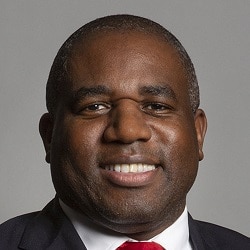
Lammy: Judicial Appointments Commission is failing
It is an “absolute scandal” that just 1% of judges are Black, the shadow Lord Chancellor has declared in the wake of figures that showed a decline in the number of solicitors on the bench too.
In all, 55% of judges are White men and 35% are White women. Black, Asian and minority ethnic (BAME) men and women each account for 5%, according to judicial diversity statistics published by the Judicial Diversity Forum yesterday.
This was because the proportion of Asian and mixed ethnicity judges has increased since 2014 to 5% and 2% respectively, but it has stayed at 1% for Black lawyers.
The statistics revealed that, over the three years to 1 April 2021, Asian, Black, mixed ethnicity and other ethnic minority lawyers were over-represented in applications for judicial appointment but – with the exception of mixed ethnicity candidates – had significantly lower recommendation rates than White people, 73% in the case of Black lawyers.
Proportions of ethnic minorities remain lower in senior court roles – 4% for High Court and above – compared to others.
The proportion of women on the bench continues to increase – 34% of court judges and half of tribunal judges – but remains lower from the High Court and above (29%).
The representation of solicitors fell throughout the judicial selection process, the statistics said. Those working as solicitors when they applied accounted for 28% of applications but only 15% of recommendations for appointment.
Overall, 32% of court judges and 64% of tribunal judges were not barristers, mostly solicitors, but only 5% in the High Court and above.
In both courts and tribunals, the proportion of non-barristers has fallen compared to 2014.
The research looked at the intersection of various characteristics – for example, female solicitors were the largest gender-profession group to apply but the smallest to succeed.
BAME barristers have lower recommendation rates than White barristers but were more likely to succeed than BAME solicitors.
Apart from White female barristers, all other gender-ethnicity-profession groups have lower recommendation rates than White male barristers
Commentary published with the findings said the difference in recommendation rates between White and non-White lawyers was “statistically significant, meaning that we can be confident that there are real differences between ethnicity groups in terms of rates of progression through to the judiciary”.
It added: “These findings demonstrate the importance of looking at ethnicity more closely, as the experiences of different ethnicity groups within the Black, Asian and minority ethnic categorisation are not the same. Looking solely at the broad group can mask underlying disparities.”
The Lord Chief Justice, Lord Burnett, said: “Although there has been some progress, there is clearly still work to be done and the judiciary is committed to playing our part.”
He pointed to the judicial diversity and inclusion strategy published last year, which aims to improve the personal and professional diversity of the judiciary at all levels over the next five years.
“The Senior President of Tribunals and I stand by and reaffirm that aim. Later in the year we will report on the measurable work we have already undertaken to support the strategy.”
But David Lammy, the shadow Lord Chancellor, said: “The Judicial Appointments Commission talks a good game when it comes to improving diversity, but ultimately their words have proved to be hollow.
“It’s an absolute scandal that after almost a decade there’s been absolutely no increase in the number of Black judges, who still make up only 1% of the judiciary.
“It is essential that our judiciary is reflective of the modern society we live in and the JAC is failing in this regard.”
Law Society president I Stephanie Boyce said it was concerned by figures, including the “overall stagnation and the proportion of solicitors leaving the judiciary”.
“As members of the Judicial Diversity Forum, we welcome the shared commitment that has been made to the creation of an action plan to tackle the clear problems with representation on the bench.
“This report has laid bare the need for urgent steps and we now need to determine as a matter of priority what those steps should be.”
Professor Chris Bones, the chair of CILEX, highlighted the need to allow CILEX Lawyers to apply for more judicial roles – 73% of CILEX members are female.
In the last year CILEX Lawyers were only able to apply for four out of the 24 judicial selection exercises, although last month Elizabeth Johnson became the first full-time CILEX judge, at the district tribunal level.
“We know there is a growing ambition and capability amongst members to take a up a judicial career,” Professor Bones said.
“CILEX members need equality of opportunity. If we truly want to make progress towards a representative judiciary, now is the time to open up the judicial eligibility criteria to lawyers of all backgrounds.”
Dr Helen Phillips, chair of the Legal Services Board, stressed the need to improve the diversity of the legal professions. “We must use the data to focus our efforts on initiatives that work and make a real difference.
“Everyone across the sector has a role to play. As the oversight regulator for legal services, we will make sure regulation plays its part in full – for example by supporting tough action on anti-inclusive misconduct and cultures, by requiring the identification of barriers to progression within the professions and dealing with them, and continuing to push for proper evaluation of interventions.”
Bar Council chair Derek Sweeting QC added: “This data should help us to take action to improve diversity in the judiciary… Until we understand whether there is problem in the appointment process, or whether the issue is experience – or both – we are operating in the dark.”
He drew attention to work the Bar Council was doing, including “a major project” to support fairer distribution of work.
“We firmly believe fairer access to quality work will support both the retention and progression of under-represented groups.
“From the perspective of judicial careers, this work must be matched by a closer look at how judges are recruited and supported to take on more senior posts in the judiciary if the efforts to diversify the legal professions are to be reflected in judicial recruitment at all levels.”














Leave a Comment